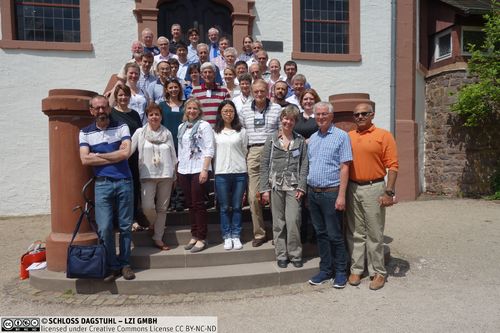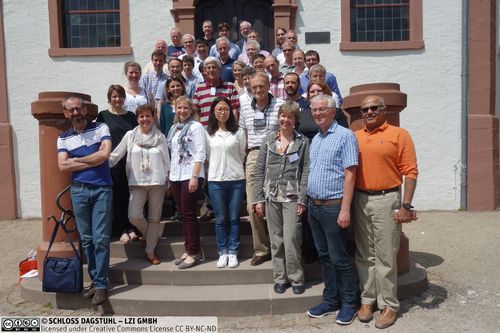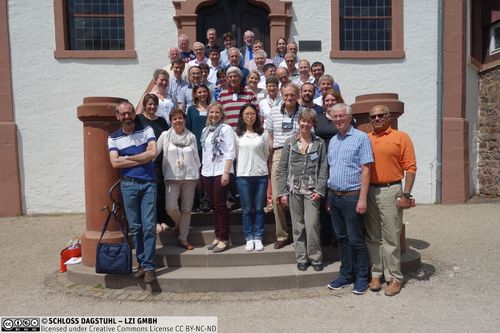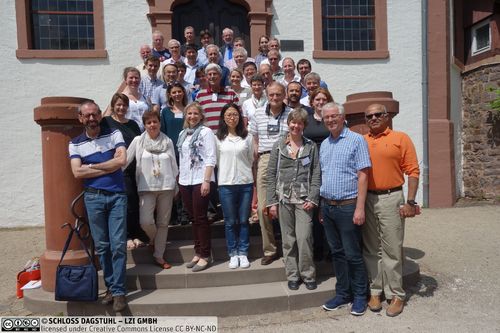Dagstuhl Seminar 17221
Geometric Modelling, Interoperability and New Challenges
( May 28 – Jun 02, 2017 )
Permalink
Organizers
- Falai Chen (Univ. of Science & Technology of China - Anhui, CN)
- Tor Dokken (SINTEF - Oslo, NO)
- Thomas A. Grandine (The Boeing Company - Seattle, US)
- Géraldine Morin (University of Toulouse, FR)
Contact
- Susanne Bach-Bernhard (for administrative matters)
Impacts
- A New Class of Guided C2 Subdivision Surfaces Combining Good Shape with Nested Refinement : article - Karciauskas, Kestutis; Peters, Jörg - Chichester : Wiley, 2018. - pp. 84-95 - (Computer graphics forum ; 37. 2018, 6).
- Computing medial axis transformations of 2D point clouds : article - Zhong, Yanjun; Chen, Falai - Amsterdam : Elsevier, 2018. - Pages 50-63 - (Graphical models ; 97. 2018 : article).
- Geometric Modeling : Interoperability and New Challenges : Special Collection - Chen, Falai; Dokken, Tor; Grandine, Thomas A.; Morin, Geraldine - Amsterdam : Elsevier Morgan Kaufmann, 2020 - (Graphical models ; 2020).
- Improved shape for refinable surfaces with singularly parameterized irregularities : article - Karciauskas, Kestutis; Peters, Jörg - Amsterdam : Elsevier, 2018. - Pages 191-198 - (CAD ; 90. 2017).
- T-junctions in Spline Surfaces : article - Karciauskas, Kestutis; Panozzo, Daniele; Peters, Jörg - New York : ACM, 2017. - 9 pp. - (ACM transactions on graphics ; 36. 2017, 5).
- Survey on the theory and applications of μ-bases for rational curves and surfaces : article - Jia, Xiaohong; Shi, Xiaoran; Chen, Falai - Amsterdam : Elsevier, 2018. - pp. 2-23 - (Journal of computational and applied mathematics ; 329. 2018, pp. 2-23).
The importance of accurate geometric models of shapes, both naturally occurring and man-made, is rapidly growing with the maturing of novel manufacturing technologies and novel analysis technologies. The advent of big data challenges and cloud-based computing serve to confound the issue even more. While previous Dagstuhl seminars on geometric modeling were focused on basic research, this seminar is focused on applications of geometric modeling. We have selected four core application areas that stretch the underlying mathematical underpinnings of the discipline to its limits and beyond:
- Big data and Cloud computing
- Multi-material additive manufacturing (3D Printing)
- Isogeometric analysis
- Design optimization
The seminar will provide a forum for leading researchers to present new ideas, to exchange scientific insights, and to bring together practical applications and basic research. The previous seminar explored the theory of shape representations, shape transformations, and computational models for each. This seminar will explore application of this theory to the four above mentioned application challenges, strengthening the reliability and performance of applications in engineering, manufacturing, and scientific exploration. The goal of the seminar is to establish a common understanding between the Geometric Modeling research community and the above application fields:
- How to handle geometric descriptions that cannot be processed by one computer but have to be distributed among many computers in the cloud
- How to process huge 3D data sets that may be noisy and incomplete into clean, scalable, and easy to access 3D environments
- How to turn big, dispersed maybe noisy and incomplete geometric data into clean, scalable, and easy to access 3D information that can be used for change detection and decision making
- How to represent, control, and process complex, anisotropic, internal material enabled by additive manufacturing, and how to design for additive manufacturing
- How to perform topology optimization of internal structure of objects to enable additive manufacturing to reach its full potential
- How to introduce analysis-based design in CAD systems with isogeometric analysis in mind
To address these questions we will bring together participants from industry urgently in need of better solutions, researchers in the application areas represented by the four topics, and researchers in the geometric modeling community whose interests align with the four topic areas. The scientific presentations will be 15 minutes. Senior researchers will give 4 overview talks on the 4 themes of the seminar. We will organize perspective working groups for each of the four topics and ask all participants to sign up for at least one working group. The length of the presentations has been shortened to allow more time for discussion and group dialog. Our goal is for each of the perspective groups to produce a "white paper" for the resulting publication.
 Falai Chen, Tor Dokken, Thomas A. Grandine, and Géraldine Morin
Falai Chen, Tor Dokken, Thomas A. Grandine, and Géraldine Morin
This report documents the program and the outcomes of Dagstuhl Seminar 17221 "Geometric Modelling, Interoperability and New Challenges".
The importance of accurate geometric models of shapes, both naturally occurring and man-made, is rapidly growing with the maturing of novel manufacturing technologies and novel analysis technologies. The advent of big data challenges and cloud-based computing serves to confound the distribution and remote access of these geometric models. While previous Dagstuhl seminars on geometric modeling were focused on basic research, this seminar was focused on applications of geometric modeling. We selected four core application areas that stretch the underlying mathematical underpinnings of the discipline to its limits and beyond:
- Big data and Cloud computing
- Multi-material additive manufacturing (3D Printing)
- Isogeometric analysis
- Design optimization
The seminar provided a forum for leading researchers to present new ideas, to exchange scientific insights, and to bring together practical applications and basic research. The previous seminar explored the theory of shape representations, shape transformations, and computational models for each. This seminar explored application of this theory to the four above-mentioned application challenges, strengthening the reliability and performance of applications in engineering, manufacturing, and scientific exploration. The goal of the seminar was to establish a common understanding between the Geometric Modeling research community and the above application fields by addressing the following questions:
- How to handle geometric descriptions that cannot be processed by one computer but have to be distributed among many computers in the cloud?
- How to process huge 3D data sets that may be noisy and incomplete into clean, scalable, and easy to access 3D environments?
- How to turn big, dispersed maybe noisy and incomplete geometric data into clean, scalable, and easy to access 3D information that can be used for change detection and decision making?
- How to represent, control, and process complex, anisotropic, internal material enabled by additive manufacturing, and how to design for additive manufacturing?
- How to perform topology optimization of the internal structure of objects to enable additive manufacturing to reach its full potential?
- How to introduce analysis-based design in CAD systems with isogeometric analysis in mind?
To answer these questions we brought together participants from industry urgently in need of better solutions, researchers in the application areas represented by the four topics, and researchers in the geometric modeling community whose interests align with the four topic areas. The scientific presentations lasted 15 to 20 minutes. Senior researchers gave 4 overview talks on the 4 themes of the seminar. Perspective working groups were organized for each of the four topics.
 Falai Chen, Tor Dokken, Thomas A. Grandine, and Géraldine Morin
Falai Chen, Tor Dokken, Thomas A. Grandine, and Géraldine Morin
- Gudrun Albrecht (Universidad Nacional de Colombia - Medellin, CO) [dblp]
- Marco Attene (CNR - Genova, IT) [dblp]
- Chandrajit Bajaj (University of Texas - Austin, US) [dblp]
- Falai Chen (Univ. of Science & Technology of China - Anhui, CN) [dblp]
- Heidi Dahl (SINTEF - Oslo, NO) [dblp]
- Tor Dokken (SINTEF - Oslo, NO) [dblp]
- Gershon Elber (Technion - Haifa, IL) [dblp]
- Daniela Fußeder (MTU Aero Engines - München, DE)
- Carlotta Giannelli (University of Firenze, IT) [dblp]
- Christina Gillmann (TU Kaiserslautern, DE) [dblp]
- Ron Goldman (Rice University - Houston, US) [dblp]
- Thomas A. Grandine (The Boeing Company - Seattle, US) [dblp]
- Jens Gravesen (Technical University of Denmark - Lyngby, DK) [dblp]
- Hans Hagen (TU Kaiserslautern, DE) [dblp]
- Stefanie Hahmann (INRIA Grenoble Rhône-Alpes, FR) [dblp]
- Dianne Hansford (Paradise Valley, US) [dblp]
- Bert Jüttler (Universität Linz, AT) [dblp]
- Panagiotis Kaklis (The University of Strathclyde - Glasgow, GB) [dblp]
- Hongmei Kang (Univ. of Science & Technology of China - Anhui, CN) [dblp]
- Benjamin Karer (TU Kaiserslautern, DE) [dblp]
- Ligang Liu (Univ. of Science & Technology of China - Anhui, CN) [dblp]
- Tom Lyche (University of Oslo, NO) [dblp]
- Carla Manni (University of Rome "Tor Vergata", IT) [dblp]
- Nicolas Mellado (Paul Sabatier University - Toulouse, FR) [dblp]
- Géraldine Morin (University of Toulouse, FR) [dblp]
- Georg Muntingh (SINTEF - Oslo, NO) [dblp]
- Jörg Peters (University of Florida - Gainesville, US) [dblp]
- Konrad Polthier (FU Berlin, DE) [dblp]
- Xiaoping Qian (University of Wisconsin - Madison, US) [dblp]
- Ulrich Reif (TU Darmstadt, DE) [dblp]
- Malcolm A. Sabin (Numerical Geometry Ltd. - Cambridge, GB) [dblp]
- Maria Lucia Sampoli (University of Siena, IT) [dblp]
- Giancarlo Sangalli (University of Pavia, IT) [dblp]
- Camille Schreck (IST Austria - Klosterneuburg, AT) [dblp]
- Hendrik Speleers (University of Rome "Tor Vergata", IT) [dblp]
- Tim Strotman (Siemens - Milford, US) [dblp]
- Georg Umlauf (HTWG Konstanz, DE) [dblp]
- Tamás Várady (Budapest University of Technology and Economics, HU) [dblp]
- Denis Zorin (New York University, US) [dblp]
Related Seminars
- Dagstuhl Seminar 9127: Geometric Modelling (1991-07-01 - 1991-07-05) (Details)
- Dagstuhl Seminar 9326: Geometric Modelling (1993-06-28 - 1993-07-02) (Details)
- Dagstuhl Seminar 9622: Geometric Modelling (1996-05-27 - 1996-05-31) (Details)
- Dagstuhl Seminar 99201: Geometric Modelling (1999-05-16 - 1999-05-21) (Details)
- Dagstuhl Seminar 02201: Geometric Modelling (2002-05-12 - 2002-05-17) (Details)
- Dagstuhl Seminar 05221: Geometric Modeling (2005-05-29 - 2005-06-03) (Details)
- Dagstuhl Seminar 08221: Geometric Modeling (2008-05-25 - 2008-05-30) (Details)
- Dagstuhl Seminar 11211: Geometric Modeling (2011-05-22 - 2011-05-27) (Details)
- Dagstuhl Seminar 14221: Geometric Modeling (2014-05-25 - 2014-05-30) (Details)
- Dagstuhl Seminar 21471: Geometric Modeling: Interoperability and New Challenges (2021-11-21 - 2021-11-26) (Details)
- Dagstuhl Seminar 24241: Geometric modeling: Challenges for Additive Manufacturing, Design and Analysis (2024-06-09 - 2024-06-14) (Details)
Classification
- data structures / algorithms / complexity
- modelling / simulation
- optimization / scheduling
Keywords
- geometric modeling
- shape design
- geometry
- computer graphics
- geometry processing
- isogeometric analysis
- additive manufacturing
- design optimization





 Creative Commons BY 3.0 DE
Creative Commons BY 3.0 DE
